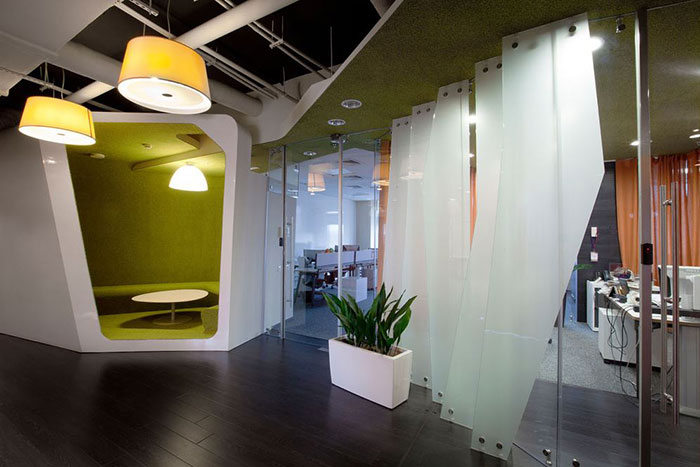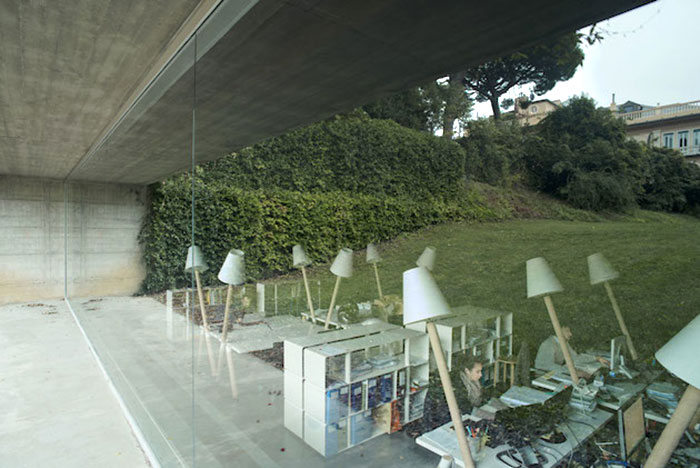
Breakout spaces like the one above designed by za bor Architects are necessary for private phone calls or more focused work in open office designs.
The discussion on introversion and extroversion is a hot topic right now. If you’ve seen Susan Cain‘s enlightening TED talk The Power of Introverts (read on if you want to watch it), then you might agree that we need to reconsider how we can support the spatial and functional requirements of introverted individuals. But it’s also true that the majority of our society consists of extroverts, so it seems to us we should be designing spaces that support both types of people.
Before we get too far ahead of ourselves though, we have 4 quick questions for you – make sure to answer all 4 and press the “done” button when you are finished. We will uncover the results of our quiz in an upcoming blog post, so check back if this interests you.
Create your free online surveys with SurveyMonkey , the world’s leading questionnaire tool.
Creating spaces that support and enhance productivity is an essential part of our job as commercial interior designers. To do that we have to be considerate of the various job descriptions that exist within our Client’s businesses, but we also need to understand the types of people that perform these duties.
For example, someone who is performing detailed technical work would typically require a quiet, organized space where they can concentrate on the task at hand. Sounds like a position fit for an introvert. However, an individual who is in sales or marketing would most likely find active spaces with group interaction more inspiring. Sounds like a position for an extrovert.
This probably seems like interior design 101, but it’s a concept we saw abandoned in the past few years. Consider the “collaborative open office” trend. Even though the implementation of office environments has heightened collaboration in the workplace and benefited extroverted activities, it’s also been extremely counterproductive for introverted workers. And of course, nobody is strictly introverted or extroverted so, how can your interior designer develop spaces that benefit all of your staff and facilitate teamwork?
1. Variety
Since there are a variety of jobs that need to get done to keep a business flowing there should equally be spaces that support these activities. Facilitate quiet zones, collaborative zones, and flexible zones by:
- scattering small breakout rooms throughout open work areas to allow for private or sensitive tasks;
- centrally locating collaborate meeting rooms, print rooms, and break rooms between closed office spaces and open work areas to foster interaction between various teams; and
- providing closed office spaces specific for job descriptions that require concentration and focus.

Gensler did a great job of including collaborative zones for recharging and facilitating team building in their design for Autodesk.
2. Nature
We all need to shut off every now and then. It’s probably true for most of us that going outside, getting fresh air and interacting with nature is the best way to quickly recharge our batteries. By providing access to nature, preferably with outdoor garden settings, but also through indoor plants or even operable windows to let in some fresh air, we can help to keep our staff feeling energized.
3. Acoustics
Whether your job requires focus or teamwork, acoustics matter. Open work areas can get noisy and distracting. Effective open offices include ways to control noise with methods such as soundmasking and absorptive materials like acoustic panels, carpet or cork flooring, and textile covered partitions.
Closed office environments also need to support private conversations and reduce reverberation. This can be done by insulating walls, ceilings, and mechanical ducting and by specifying absorptive materials such as acoustic ceilings, carpet or cork flooring, upholstered seating, and textile wall coverings.

Carlos Bagliani understood the power of nature in office settings by integrating large expansive windows to a green garden area for this modern, underground office design.
By designing spaces that assist employees to successfully perform their jobs, Interior Designers serve an important role in facilitating the success of a company. Although we agree that we need to reconsider how we can support spatial and functional requirements of introverted workers, we also think there is power in a team that can efficiently work together and independently. Thoughtfully designed workplaces provide our employees with the power to choose a zone that best supports the immediate task and therefore caters to both introverted and extroverted activities.